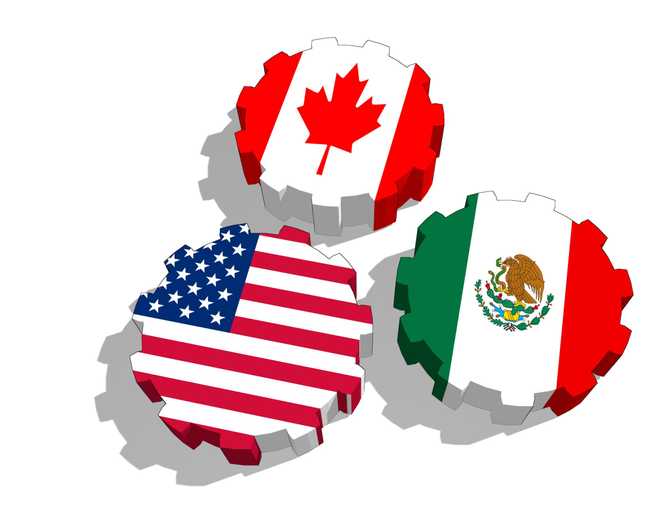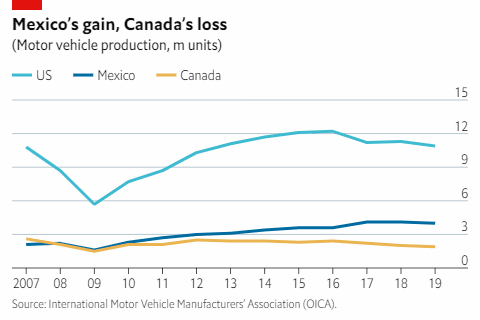Last Updated on April 1, 2024

The United States-Mexico-Canada Agreement (USMCA) ushered in a new era of North American trade cooperation. This agreement presents a wealth of opportunities for manufacturers in Texas. By strategically partnering with Mexican companies, Texas manufacturers can strengthen their supply chains, expand their customer base, and boost their bottom line.
What is the USMCA?
USMCA (United States-Mexico-Canada Agreement) replaces NAFTA (North American Free Trade Agreement). The agreement was signed by the leaders of the United States, Mexico, and Canada on November 30, 2018, and it took effect on July 1, 2020.
In addition to market access for goods and services, digital trade, intellectual property, labor and environmental standards, and dispute settlement, the USMCA aims to increase trade and investment among the three countries. By modernizing trade rules and regulations, the agreement will better reflect the reality of 21st century economics.
Trade, investment, and job creation in all three countries are expected to increase as a result of the USMCA. NovaLink, for instance, benefits significantly from the USMCA as a result of its nearshore manufacturing partnership.
Capitalizing on Geographic Proximity
Texas shares a long border with Mexico, offering a significant logistical advantage. Imagine this: you need a critical component for your production line. Instead of waiting weeks for it to arrive from overseas, your Mexican partner can deliver it quickly and efficiently, minimizing downtime and keeping your production humming. Proximity also fosters closer collaboration, allowing for easier communication and streamlined problem-solving.
In the fast-paced world of electronics manufacturing, the ability to swiftly address issues, iterate designs, and make decisions is critical. Local manufacturing enhances this capability by enabling real-time communication and face-to-face interactions. This proximity not only facilitates a more cohesive working relationship between your company and the manufacturer but also fosters a culture of collaboration. Teams can work together more seamlessly, share insights more readily, and reach solutions more quickly. This environment of close collaboration often leads to innovation, as ideas can be more easily discussed, prototyped, and tested.
August Electronics
A Complementary Manufacturing Ecosystem
Mexico boasts a skilled and competitive workforce, making it an ideal location for specific manufacturing processes. Texas manufacturers, on the other hand, excel in high-tech production and advanced engineering. By partnering, these companies can create a complementary manufacturing ecosystem. Texas companies can leverage Mexico's strengths in labor-intensive tasks, while focusing on their core competencies in Texas. This win-win scenario allows both sides to optimize their production processes and become more globally competitive.
Example of a Manufacturing Ecosystem
Let's take a fictional Texas-based company Acme Widgets, a high-precision machinery company in Texas. Their core competency lies in designing, engineering, and crafting the intricate mechanisms that make their widgets function. However, assembling these widgets involves a lot of repetitive tasks like screwing parts together, applying delicate finishes, and quality control checks.
Partnering with a Mexican Manufacturer
By partnering with a Mexican manufacturer, Acme Widgets can offload these labor-intensive tasks to their Mexican partner. The Mexican manufacturer will have a skilled workforce adept at handling these precise yet repetitive tasks, often at a competitive cost due to Mexico's labor market.
Win-win Results
A win-win situation. Acme Widgets gets a cost-effective and efficient assembly process, while their Mexican partner benefits from steady work and technology transfer opportunities. This exemplifies how Texas manufacturers can leverage Mexico's strengths in labor-intensive tasks, allowing them to focus on their core competencies and excel in the global market.
Meanwhile, Acme Widgets in Texas can focus on their core competencies.
Their engineers can continue refining their designs, and their skilled machinists can concentrate on crafting the complex parts that require high-level expertise. This allows Acme Widgets to maintain their competitive edge in innovation and quality control, while the Mexican partner efficiently handles the assembly.
Unlocking New Markets
The USMCA streamlines trade between the three signatory nations: the U.S., Mexico and Canada. This presents a golden opportunity for Texas manufacturers to tap into the vast Mexican market. Mexico has a population of over 128 million, offering a significant customer base for Texas-made goods. By partnering with a Mexican company with established distribution channels, Texan manufacturers can gain a foothold in this lucrative market. This is without the hassle of navigating complex regulations on their own.
The Perryman Group estimates that trade with Mexico generates business activity across the United States of about $998.7 billion in gross domestic product annually and more than 8.1 million jobs (including multiplier effects and based on 2023 trade levels). For Texas, the total benefits include an estimated $471.4 billion in gross product and over 3.6 million jobs (again based on 2023 trade levels), with the border region comprising $28.9 billion in gross product and more than 301,000 jobs of the state totals. About 25% of all activity in the vast Texas economy is thus tied to interactions with Mexico.
Perryman Group
Building a Stronger North American Manufacturing Bloc
The USMCA fosters a more integrated North American manufacturing landscape. Texas manufacturers can leverage this integration to create a more robust and resilient supply chain. Imagine a scenario where a critical component sourced from Asia is disrupted. By partnering with Mexican companies that have alternative suppliers within the USMCA region, Texas manufacturers can mitigate such risks and ensure a steady flow of materials.

Conclusion: The USMCA Offers Texas Manufacturers Unparalleled Growth and Expansion Opportunities
In conclusion, the United States-Mexico-Canada Agreement presents Texas manufacturers with unparalleled opportunities for growth and expansion. By forging strategic partnerships, optimizing supply chains, and embracing cultural diversity, companies can position themselves as leaders in the global market. Leveraging the USMCA's advantages is not just about maximizing profits—it's about building sustainable partnerships and driving innovation for a brighter future.
FAQs on Texas Manufacturers Partnering with Mexico
1. How can Texas manufacturers find suitable partners in Mexico?
- Texas companies can utilize business networks, trade associations, and online platforms to connect with potential partners in Mexico. It's essential to conduct thorough research and due diligence to ensure compatibility and alignment of goals.
2. What are the key benefits of partnering with Mexican companies under the USMCA?
- Partnering with Mexican firms enables Texas manufacturers to access new markets, reduce production costs, and navigate regulatory challenges more effectively. Additionally, it fosters cultural exchange and promotes innovation through collaborative efforts.
3. How can Texas manufacturers ensure compliance with USMCA regulations?
- To ensure compliance with USMCA regulations, Texas manufacturers should stay updated on trade policies, invest in proper documentation and record-keeping, and seek legal counsel when necessary. Regular audits and assessments can also help identify areas for improvement.
4. What role does technology play in maximizing the USMCA advantage?
- Technology plays a crucial role in optimizing operations and facilitating communication between Texas manufacturers and their Mexican partners. Embracing digital tools and automation streamlines processes, enhances efficiency, and promotes real-time collaboration across borders.
5. How can Texas manufacturers mitigate risks associated with cross-border trade?
- Texas manufacturers can mitigate risks associated with cross-border trade by diversifying their supplier base, implementing robust risk management strategies, and maintaining open communication channels with partners. Additionally, staying informed about geopolitical developments and market trends is essential for making informed decisions.
About NovaLink
As a manufacturer in Mexico, NovaLink employs a unique approach that transcends the traditional model of shelter production. More than just the location of your manufacturing, we would like to become a partner in your manufacturing in Mexico. You will be able to relocate or initiate manufacturing for your company in Mexico in a low-cost labor environment with very little delay or up-front costs. Find out how we can help you by handling the manufacturing process.
There are NovaLink facilities in the border cities of Brownsville, Texas, Matamoros, Mexico, and Saltillo, Mexico.
Explore More: Discover Related Blog Posts
Expand your knowledge and delve deeper into more information about Texas and Mexico manufacturing with our curated collection of related blog posts.
- Top 10 Reasons to Move Your Manufacturing Operations to Mexico
- Strengthening Your Supply Chain: How Texas Manufacturing Companies Benefit from Mexican Partnerships
- Maximizing the USMCA Advantage: Texas Manufacturers Partnering with Mexico
- Closer to Home: Why Texas is a Prime Location for Nearshoring Manufacturing
- Strategic Shifts: Texas Manufacturing Companies and the Nearshoring Movement